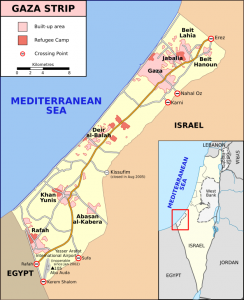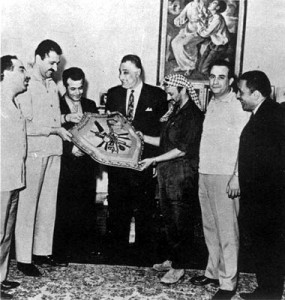One person has been enjoying every minute of this summer’s fifty-day war on Gaza. He was known formerly as Abu Bakr al-Baghdadi, until he changed his name to Caliph Ibrahim. His self-proclaimed ‘Islamic State’ has been winning recruits by the dozen every time a child is killed in Gaza while his jihadi networks are gaining traction with each Israeli shell that detonates among his arch-enemies from Hamas.

Until July, the ‘Caliph of Terror’ could count mainly on the Syrian and Iraqi dictators for support. Assad and Maliki were so keen on slaughtering their moderate oppositions that they left the ground wide open for Baghdadi’s shock troops in Raqqa and Mosul. But now, the jihadi Supreme Commander has found two new playmates: Netanyahu and Sisi.
The Egyptian General has been so relentless in hunting down the Muslim Brotherhood that support for their main jihadi rivals has grown exponentially. They are now entrenched in Northern Sinaï, betting on Sisi’s animosity against Hamas to doom any Egyptian-sponsored truce in Gaza. Meanwhile, the Israeli prime minister, in the name of a Hamas-free Gaza, might have favoured unwillingly a Baghdadi-inspired ‘Islamic State’ on both sides of the Egyptian border.
My fellow historians of the next generation may well look back with dismay at the passivity of world leaders when faced with such a catastrophe in the making. America is not even pretending to lead from behind. It has decided to tie its own hands once and for all and the EU has been bullied so repeatedly into inaction by Washington that it only dares to foot the bill for the next bout of EU-sponsored ruin-rebuilding in Gaza. Meanwhile the Israelis simply ignore the UN, which is paralysed between the US veto on Israel and the Russian veto on Syria.

This collective impotence is all the more striking since the Gaza Strip, with no border issue at stake, and no Israeli settlers left in situ since 2005, is a far less complex issue to handle than Jerusalem and the West Bank. Nevertheless the bankrupted ‘peace process’ has produced an entire clique of ‘peace-lords’, led by Smiling Tony (Blair), whose major interest is for the show to rumble on – with the attendant benefits that entails.
One should not forget that in the seven years before this all-out war, Gaza’s 1.8 million inhabitants were subjected to a collective siege that was indisputably an act of war (as any student of international law knows). So a comprehensive and durable ceasefire can be based only on the end of all aggression from both sides, which implies, of course, the lifting of the blockade. The 26 August agreement falls far below that prerequisite.
The population of the Gaza Strip consists of the local inhabitants of the territory in 1948 and their descendants (one third), and the refugees who fled there after the creation of the state of Israel and their descendants (two-thirds). If it were not for the Sinai desert, these 1.2 million Palestinian refugees would now be packed in camps surrounding Cairo and Alexandria, as happened in Jordan, Syria and Lebanon. The Zionist leadership was totally unprepared for the existence of such a concentration of Palestinian refugees on Palestinian land, since Egypt, unlike Jordan, refused adamantly to annex the Gaza Strip.
Israel has tried everything in Gaza, and failed repeatedly, at a horrendous cost for the Palestinian population. In 1949, Ben Gurion ‘offered’ to annex the Gaza Strip and resettle its refugee population in Israel proper, an ‘offer’ that was flatly rejected by both the UN and the US. Then Israel launched its ‘secret’ Unit 101, headed by Ariel Sharon, that led murderous raids into Gaza in order to ‘terrorise the terrorists’. This, naturally, has had the reverse effect.

During four long months in 1956-57, Israel occupied Gaza for the first time, adamant in its resolve to destroy this ‘fedayin nest’. More than a thousand Palestinians were killed in the process (out of 300,000 inhabitants). Then, from 1957 to 1967, Israel relied on Nasser to enforce the ceasefire in Gaza, which he did, but the Palestinian Liberation Organisation (PLO) and the Palestinian Liberation Army (PLA) had to be created under Cairo’s auspices in order to defuse Palestinian nationalist frustrations.
In 1967, Israel occupied Gaza for the second time and faced a four-year-long low-intensity guerrilla campaign waged by both PLA and PLO factions. Sharon, the occupation’s commander, displaced one in ten Gaza residents in order to literally bulldoze the armed uprising. Then Israel tried ‘divide and rule’, facilitating the development of an Islamist movement to counter the PLO nationalists. All this culminated in 1987 with the first intifada and the foundation of Hamas.
Itzhak Rabin was probably the only Israeli leader with a vision for Gaza: he wanted to withdraw his armed forces from the territory and promote instead a functional Palestinian Authority (PA). This ‘Gaza first’ strategy nurtured the dynamics of the Oslo Agreements in 1993 and the installation of the Yasser Arafat-led PA in Gaza in 1994. But Rabin was murdered in 1995 and, after a brief Peres interlude, Netanyahu took over. His aggressive policy against the PA only served to spread instability into Gaza and strengthen Hamas. This downward spiral fuelled the second intifada and its disastrous cycle of indiscriminate bombings and terror attacks.
Sharon, prime minister in 2001, kept on the offensive against the PA. He thought he could kill two birds with one stone in 2005 with his ‘unilateral withdrawal’ from Gaza: first, by ridding Israel of a security liability; and second, in stemming the tide of Palestinian statehood by dividing the Gaza strip from the West Bank. This seemed to work for a while, purely in Israel’s interests, and exacted a terrible toll on the Palestinians. And then it collapsed again, irrespective of how much ‘lawn-mowing’ Israel carried out during its various offensives.
There is no way out of the Gaza trap other than via the two-state solution between Israel and Palestine. This might seem far-fetched today, but compared to the miserable failure of all the other options to date, it should be the only reasonable choice. Israel moved in 2005 from a direct occupation of Gaza to an indirect one, which proved even more murderous for the Palestinians. Now it must address the fate of its Palestinian neighbours in order to secure its own future.
The last round of hostilities has proved the scandalous futility of the so-called ‘military option’, which is not an option but an impasse. None of the declared Israeli war objectives has been attained, despite the 6 billion dollars of destruction wrought in Gaza and the 2 billion dollars the offensive cost the Israeli exchequer. Imagine what could have been achieved if those 8 billion dollars had been spent in development projects in the Gaza Strip?
This is the sole alternative to this seemingly endless cycle of wars: a genuine development of the Gaza Strip that would drain from the militias the pool of angry young men who till now have no employment opportunities other than to join one of the militias. Israel demands Gaza’s demilitarisation, but such demilitarisation can be obtained only through the lifting of the current blockade.
Do not count on Sisi to turn peacemaker: if the Gaza strip is effectively stabilised and pacified, how can he justify the billion dollars or more a year his dictatorship receives in US aid? This matter must be settled between Israel and the PA, since Israel is not ready to deal with Hamas, while the PA, through the ‘national reconciliation’ brokered last spring, is empowered to speak on behalf of the Islamist movement.
Determined international backing of Israeli-Palestinian talks is imperative if we do not want the current truce to be only a lull before the next war. The European Union could not only monitor the crossing points from the Gaza Strip into Israel and Egypt, but could also establish a much-needed and long overdue sea-link between Gaza and Cyprus.
Much more could and should be done without waiting for Washington’s green, or even orange, light. The clock is ticking, and the ‘Caliph of Terror’ is betting on our collective blindness and cowardice. Let’s prove him wrong. Don’t let the Gaza trap snare both Israelis and Palestinians alike.
 Jean-Pierre Filiu is Professor of Middle East Studies at Sciences Po in Paris and author of The Arab Revolution: Ten Lessons from the Democratic Uprising and, most recently, Gaza: A History.
Jean-Pierre Filiu is Professor of Middle East Studies at Sciences Po in Paris and author of The Arab Revolution: Ten Lessons from the Democratic Uprising and, most recently, Gaza: A History.
More books on Israel and Palestine →